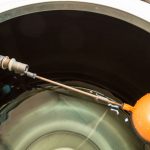Water Leak Detection for Apartments and Multi-Family Buildings: A Landlord’s Guide
 In the realm of property management, particularly within apartments and multi-family buildings, water leak detection for apartments stands as a pivotal concern for landlords. The consequences of undetected leaks stretch far beyond mere water wastage, encompassing severe financial repercussions, potential health risks due to mold and mildew, and substantial damage to the property’s structural integrity. This guide delves into the critical aspects of water leak detection, offering landlords a detailed roadmap to safeguard their investments and foster a safe, healthy living environment for their tenants.
In the realm of property management, particularly within apartments and multi-family buildings, water leak detection for apartments stands as a pivotal concern for landlords. The consequences of undetected leaks stretch far beyond mere water wastage, encompassing severe financial repercussions, potential health risks due to mold and mildew, and substantial damage to the property’s structural integrity. This guide delves into the critical aspects of water leak detection, offering landlords a detailed roadmap to safeguard their investments and foster a safe, healthy living environment for their tenants.
Understanding Water Leaks
Water leaks in multi-family dwellings can manifest in various forms, ranging from overt pipeline bursts to covert, slow drips within walls. Recognising the different types of leaks—be it from faulty plumbing, compromised roofing, or other sources—is crucial for implementing effective detection and prevention strategies. The common causes of these leaks often relate to wear and tear, inadequate construction, or environmental factors, underscoring the need for regular inspection and maintenance to mitigate potential risks.
The Cost of Neglect
Ignoring water leaks can precipitate a domino effect of detrimental outcomes. The immediate consequences might seem manageable, but the long-term implications on property value and health are profound. Unaddressed leaks can lead to mold proliferation, which poses serious health threats to residents and compromises the structural soundness of the building, ultimately diminishing its market value. The financial burden of extensive repairs, alongside potential lawsuits from affected tenants, can be staggering, emphasizing the economic wisdom in proactive leak management.
Water Leak Detection for Apartments: Technological Solutions
The technological landscape offers a plethora of innovative solutions for water leak detection for apartments, from simple moisture sensors to sophisticated, AI-powered monitoring systems. These tools can provide real-time alerts to the presence of water where it shouldn’t be, enabling swift action to prevent further damage. This section explores the merits of various detection technologies, offering guidance on selecting and implementing the most effective systems for your property.
Preventative Measures
 Adopting a proactive approach to water leak prevention is paramount. Regular maintenance checks, including plumbing inspections and roof assessments, can significantly reduce the likelihood of leaks. Additionally, educating tenants about the importance of reporting potential leaks and providing them with the knowledge to identify warning signs can foster a collaborative environment conducive to early detection.
Adopting a proactive approach to water leak prevention is paramount. Regular maintenance checks, including plumbing inspections and roof assessments, can significantly reduce the likelihood of leaks. Additionally, educating tenants about the importance of reporting potential leaks and providing them with the knowledge to identify warning signs can foster a collaborative environment conducive to early detection.
Early Detection Strategies
Early detection is key to minimising the impact of water leaks. This involves not only the adoption of technological solutions but also a commitment to regular, visual inspections by property management. Strategies such as routine walkthroughs, tenant education programs, and the installation of water detection devices can all play a critical role in identifying leaks at their inception.
Leak Repair and Management
Upon detecting a leak, timely and effective repair is critical. This section outlines the decision-making process between undertaking repairs in-house versus contracting professional services, considering factors such as the leak’s complexity, potential disruption to tenants, and cost implications. Effective communication and coordination with tenants during the repair process are also discussed, ensuring minimal inconvenience and maintaining trust.
Legal and Insurance Considerations
Navigating the legal landscape and insurance policies related to water leaks can be complex. Landlords must be acutely aware of their liabilities and the legal obligations to maintain habitable living conditions. This section provides an overview of common legal considerations and tips for effectively managing insurance claims related to water damage, aiming to protect landlords from potential litigation and financial loss.
Cost-Effective Solutions
While the upfront costs of leak detection and prevention measures may seem daunting, the long-term savings are substantial. This segment offers insights into budgeting for water leak management, highlighting cost-effective strategies and potential financial incentives available through government and utility conservation programs.
Tenant Communication and Support
Effective communication with tenants is crucial, particularly in the context of leak detection and repair. Establishing clear, accessible reporting channels and maintaining transparency throughout the repair process can alleviate tenant concerns and foster a positive landlord-tenant relationship. This section also covers best practices for managing tenant relocations during extensive repairs, ensuring a smooth, respectful process.
Future of Water Leak Detection for Apartments
The future of water leak detection in multi-family buildings is promising, with advances in technology offering more efficient and accurate methods for identifying leaks. The integration of artificial intelligence and machine learning into detection systems promises to revolutionize how landlords manage water leaks, making prevention and early detection easier and more effective.
FAQs
Q: How can landlords detect water leaks early in apartments? A: Landlords can detect water leaks early by using moisture sensors, AI-powered monitoring systems, and conducting regular inspections. Educating tenants to report potential leaks immediately also aids early detection.
Q: What are the common causes of water leaks in apartments? A: Common causes include faulty plumbing, compromised roofing, wear and tear, and environmental factors. Regular maintenance and inspections can help mitigate these risks.
Q: What should landlords do if they detect a water leak? A: Upon detecting a leak, landlords should promptly assess the damage and decide whether to perform repairs in-house or hire professionals. Communicating with tenants about the situation and expected repairs is also crucial.
Q: What are the legal responsibilities of landlords regarding water leaks? A: Landlords are legally obligated to maintain habitable living conditions, which includes addressing water leaks promptly. Failure to do so can result in legal and financial consequences.
Q: Are there cost-effective solutions for water leak detection? A: Yes, there are several cost-effective solutions, including installing moisture sensors and leveraging government and utility conservation programs for financial incentives. Regular maintenance can also prevent costly repairs in the long run.
Conclusion
Effective water leak detection for apartments and multi-family buildings is a complex but essential task for landlords. By adopting a comprehensive approach that includes understanding leaks, utilizing technology, implementing preventative measures, and fostering open communication with tenants, landlords can protect their properties and ensure the safety and satisfaction of their tenants. Proactive water leak management not only saves money and prevents damage but also contributes to a positive living environment, ultimately benefiting both landlords and tenants alike.
To book a leak inspection now and speak to one of our experts, click the link below.





